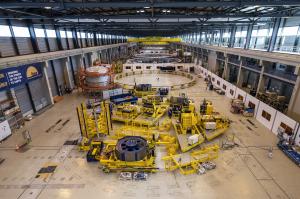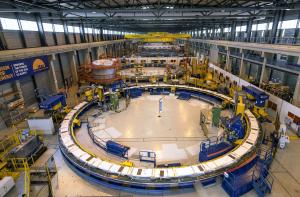Seven years of faithful service
In November 2015, workers from the European contractor Sea Alp Engineering, an Italian company based in Turin, began installing a large circular structure at the south end of the on-site Poloidal Field Coil Winding Facility. As weeks and months passed, more tooling was added, with functions that were quite inscrutable for the non-specialists: sturdy tower-like devices, what looked like a giant tape dispenser, walkways, gantries, steel cylinders and electrical cubicles. All in all, some 350 tonnes of equipment for Europe's "coil winding station."
For the past seven years, this unique combination of tooling and machinery has fulfilled its mission—turning more than 50 kilometres of jacketed niobium-titanium cable delivered by China into 30 production "double pancakes" required by the four large ring-shaped poloidal field coils manufactured on site by Europe.
During winding phase of production, spooled conductor was uncoiled and straightened before it passed through cleaning and sandblasting to prepare its surface for several layers of glass-fibre insulating tape. Then, as the winding table rotated slowly, the conductor was wound into double-layer pancakes in the precise dimensions required for the coil in question—either 17 or 24 metres in diameter. These double pancakes then moved down the line to the other production stations of the coil winding facility.
Dismantling operations began early August and lasted throughout the month. Where the table and its machinery once stood, individual components are now waiting to be moved out of the building and, possibly, to start a new life in a new environment. On 28 July 2022 the Official Journal of European Union posted a "prior information notice" for the sale of these highly valuable assets. In the vast clean space that has been cleared, the ITER Organization will be installing a new kind of station: three port plug test stands to put the steel plugs that will seal off each tokamak port opening to the test before their installation in the machine.
The disposal of the winding installation and the reassignment of the space it occupied does not signify the end of coil production activity in the facility. The two largest coils (24 metres in diameter) are still in production, with expected completion dates of mid-2023 (PF4) and mid-2024 (PF3) respectively.
Beginning in 2012 with the delivery of the 13,000-square-metre production facility, the making of ITER's four largest poloidal field coils has brought together hundreds of specialists from more than a dozen European contractors.
Beyond the challenges of manufacturing components of a size and complexity never achieved before, the success of this formidable industrial adventure has rested on the close coordination of contractors and a sharp learning curve that considerably reduced manufacturing time over the years (see box).



